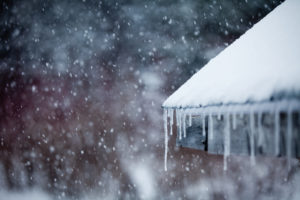
Many homeowners fail to realize the importance of winterizing their homes. Failing to properly prepare your house for cold winter weather puts you in jeopardy for a variety of serious consequences, ranging from interior leaks to fires and more. By preparing your home’s interior and exterior now, you can greatly reduce your odds of having any problems when snow and frigid temperatures strike. Follow these ten suggestions to keep you, your family, and your home safe and sound this winter:
Exterior:
- Inspect your roof. . Ensuring that your roof is in good condition is one of the most important steps you can perform in winterizing your home. If you’re uncomfortable with inspecting your roof yourself, hire a professional. The cost of the inspection is small compared to the expense that roof issues can cause if they’re not addressed. If you opt to perform the inspection yourself, make sure that all shingles are intact and securely attached. During the cold winter months, it’s not uncommon to experience high winds, which can ultimately lead to loose shingles being blown off your roof. Be on the lookout for holes or cracks in any of the flashing around your roof vents too. Openings like these in roof flashing can lead to water penetration inside your home.
- Clean your gutters. Clogged gutters are one of the most common culprits of water damage in a home. To properly winterize your residence, it’s important to make sure your gutters are clear of leaves and debris from trees, such as small sticks. Hire a gutter cleaning company or if you do it yourself, remove leaves and debris from your gutters and then use a garden hose to flush out any remaining particles and to ensure that the water is draining properly.
- Get your chimney cleaned. Hire a professional chimney sweep to clean and inspect your chimney for any issues that need attention before using it. This will avert chimney fires and will prevent carbon monoxide from creeping into your home.
- Winterize your air conditioners. If you have central air conditioning, make sure that all debris is cleared away from the unit. Then, cover the unit with a piece of wood that’s large enough to cover the entire top surface. This reduces the chance that leaves or other debris can fall inside thee unit and damage it. If you have window units, drain any water from them and then wipe them down before storing.
- Prepare your landscaping. There are many products on the market available for lawn winterization and they can make e a big difference in how your lawn looks after harsh winter weather. It’s also suggested to prune shrubs and bushes in the late fall or early winter season. Properly pruning your shrubs and bushes will increase the amount of oxygen they receive, which will ultimately lead to healthier growth in the spring.
Interior:
- Get a heating system tune-up. Do a survey of your home’s heating vents to make sure they’re not blocked or covered by furniture, carpeting, or curtains. Hire an HVAC professional to inspect your furnace to test for leaks, check heating efficiency, and change the filter. They can also do a carbon monoxide check to ensure air safety.
- Clean and check smoke alarms and detectors. Make sure the covers of your smoke alarms and carbon monoxide detectors are clean. A smoke alarm that has built up dust may not function like it should. Simply wipe them down with a damp rag. Use the “test” feature on your alarms to ensure that they’re functioning properly. You should also replace the batteries in all detectors prior to the winter season.
- Check for drafts. According to the U.S. Department of Energy, drafts can waste 5 to 30 percent of your home’s energy use. Feel for drafts around the edges of your windows and doors. If necessary, replace the seals and repair caulking around window and door frames.
- Put up storm windows. If you have removable screens, it’s time to replace them with storm windows. Hose off or vacuum all screens, inspect them for any holes, tears, or other damage, and repair as necessary. Store them in a safe place away from foot traffic, such as a garage or basement.
- Reverse the direction of your ceiling fans. Did you know that using your ceiling fan in the winter can actually save you money on your utility bills? Make sure your ceiling fans are set in the clockwise direction. By doing so, it creates an upward airflow which decreases the amount of time it takes for the heat to rise and heat your home, reducing the load on your heating system. Be sure to keep the fan speed on low to avoid creating drafts.
By taking the right steps now to protect your home against possible winter threats, you can save thousands of dollars on repairs and potential replacements.
Certified Title is a Title Insurance, Search and Settlement Services provider that uses the latest technology to make managing documents, communicating and closing transactions a breeze. To learn more, visit Certified Title today or call (888) 486-5511.

